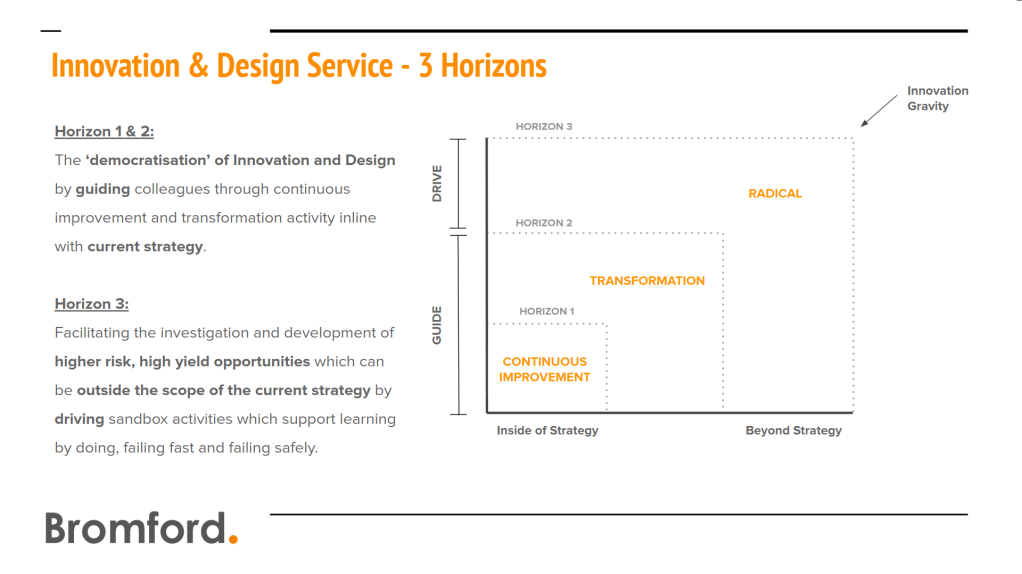The interior secrets of black holes are guarded by a one-way light-trapping boundary called the event horizon.
This horizon is the point, according to NASA, that the gravitational influence of the black hole becomes so intense that not even light is fast enough to escape it.
A very different horizon exists in many organisations, except in this case instead of consuming light, it sucks up people, resources and time, leaving the business with little, if any, capability for creativity. This is the Mediocrity Horizon, and it occurs when the existing core business is taking everyone’s full-time attention, leaving no room for any serious contemplation of the future.
Many of us are keenly aware that BAU – Business as Usual – is not good enough any more. On one hand it is accepted that you don’t innovate you will cease to be, but in truth most large organizations have difficulty managing the tension between progress (innovation) and BAU which is for all intents and purposes corporate risk avoidance.
BAU and risk avoidance are healthy things to see in highly organised and high performing organisations with little competition. I remember visiting Apple years ago and being struck by how regimented and constrained it was, the products and service was designed to such a high degree that any deviance wasn’t tolerated. You don’t mess with success around here.
Unfortunately, many of our organisations don’t have such luxury as we preside over broken legacy empires with an excess of failure demand.
It is in those systems where all eyes begin to focus on one horizon and one horizon only – the here and now – and ponder how the hell we fix today’s problems.
Now of course, organisations should focus on their core but today we require leaders and influencers who are strategically informed about emerging trends and their future implications.
We’ve been using and writing about the three horizons model for some time, it’s a useful way of helping people to think about the future and to move beyond a short-term time frame.
Just to remind ourselves it breaks down as follow:
Horizon 1 (H1): The here and now. It represents the organisation’s core business activities and focuses on current operations, products, and services. It involves managing and optimising.
Horizon 2 (H2): The next bet. This involves emerging opportunities and initiatives that have the potential to become significant contributors to the organisations future growth. This horizon includes innovations and new business models that are being developed and refined for future scalability.
Horizon 3 (H3): A disruptive presence on the horizon. This represents longer-term and more speculative opportunities that could become the organization’s future. This horizon involves exploring and experimenting with disruptive innovations, potentially in or with new markets or industries.
The three horizon model is not the depiction of three consecutive phases, but rather it provides a way to bucket your time and efforts. It’s common to hear of a 60-30-10 ratio.
That’s 60% of resources being applied to the here and now, 30% to exploring bets on the future, and 10% on longer-term speculation.
However, to return to my original proposition, I don’t think in many organisations the split is anything like this. In many public sector organisations, the split would more likely be 90-5-5. At best.
Some businesses are so focused on short term thinking , short term reward and recognition and their existing business processes they can’t begin to think beyond the first horizon.
We can see the effects of short term thinking on our housing supply, within a creaking social care system and as part of our NHS. And we can also see how short term thinking can even jeopardise longer term projects like HS2 and Net Zero 2050.
One of the benefits of mapping all your organisational activity across the three horizons is you’ll see all too soon that nearly all resources are focused on the now, on keeping people as busy fools.
People get busier and more exhausted, new people get brought in to solve the problems other people haven’t. Projects get later, so more resources are thrown at them. People get busier. People get exhausted.
The good news is you can break out of the cycle quite easily. As I’ve written before every new strategy gives an organisation the opportunity to spend less time being busy on the present and more time contemplating the future. Anti-gravitational activities can be seeded quite quickly by engaging more people in consideration of the future and allowing them to imagine different possibilities.
A black hole is a region where spacetime is so curved that every possible path which light could take eventually curves and leads back inside the black hole. Once a ray of light enters a black hole, it can never exit.
In an organisation wholly focused on the present every possible path forward eventually curves back on itself and leads back to the mediocrity horizon. Once any resource enters the business as usual timeframe, it can never exit.
It just craves more resource.
Related: Autonomy Only Happens by Design





